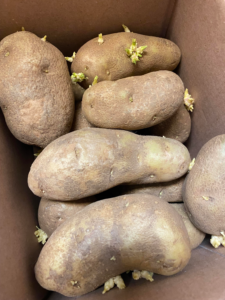Coming across potatoes with sprouts in your kitchen is pretty common, especially if they’ve been stored for an extended period. The question is, are sprouted potatoes safe to eat, or should they be discarded? Here, we’ll explore everything you need to know about sprouted potatoes, including how to tell if they’re safe to consume and tips on proper handling.

What Happens When Potatoes Sprout?
Potatoes sprout when they develop shoots, often called “eyes.” This happens when potatoes are stored for too long or are exposed to light and warmth. Essentially, sprouting is the potato’s way of beginning to reproduce and grow into a new plant. While sprouting itself isn’t necessarily harmful, it does affect the quality and safety of the potato.

The process of sprouting leads to changes in the potato, such as the development of green patches or areas. These green spots are not just unsightly; they indicate an increase in a naturally occurring toxin called solanine, which can be harmful if consumed in large amounts.
Are Sprouted Potatoes Safe to Eat?
The safety of eating sprouted potatoes largely depends on the condition of the potato and how it is handled. Here are some factors to consider if you’re deciding whether or not to eat sprouted potatoes:
- Remove the Sprouts and Green Areas:
If your potatoes have sprouted, you can still use them by carefully removing the sprouts and any green patches. The sprouts and green areas contain solanine—a natural toxin that develops as a defense mechanism. Eating too much solanine can lead to health issues, including nausea, headaches, and digestive discomfort. By cutting away these parts, you significantly reduce the risk associated with eating sprouted potatoes. - Check for Other Signs of Spoilage:
Besides sprouts, it’s important to check for any other signs of spoilage before cooking. If a potato feels soft, looks shriveled, or has a strong, unpleasant odor, it’s best to throw it away. These signs indicate that the potato has deteriorated beyond the point of safe consumption, and eating it could pose health risks. - Cook Thoroughly:
Cooking sprouted potatoes thoroughly can help reduce the solanine content and make them safer to eat. However, it’s still advisable not to consume large quantities of sprouted potatoes, especially if they have significant green areas. Cooking can minimize but not completely eliminate solanine. Therefore, if there’s any doubt about their safety, it’s better to err on the side of caution and discard them.
Why Are Sprouted Potatoes a Concern?
Sprouted potatoes are concerning primarily because of their increased solanine levels. Solanine is a toxic compound that forms as part of the potato’s natural defense mechanism when exposed to light or stored improperly. It accumulates in the green areas of the potato, and eating too much can lead to symptoms like nausea, headaches, and digestive problems.
The green coloring you often see on sprouted potatoes is a sign of solanine buildup. This is why it’s essential to remove any green portions and sprouts before cooking or eating the potato. Solanine toxicity can cause health issues that are easily avoided by proper handling and preparation.
How to Prevent Potatoes from Sprouting
Prevention is key when it comes to keeping your potatoes from sprouting. Here are some effective ways to store potatoes properly and reduce the chances of sprouting:
- Store in a Cool, Dark Place:
Potatoes are best stored in a cool, dark environment with plenty of ventilation. Light encourages the production of solanine, which turns parts of the potato green. Ideally, keep your potatoes in a pantry or cellar where temperatures are stable and cool. Also, avoid storing potatoes in the refrigerator; cold temperatures can cause the starches in the potato to convert to sugars, affecting the texture and taste. - Use Proper Storage Containers:
It’s best to use breathable containers for storing potatoes, such as paper bags or baskets. Avoid plastic bags, as they trap moisture, which accelerates sprouting and spoiling. Containers that allow for airflow help keep the potatoes fresh longer. - Keep Away from Onions:
Potatoes and onions don’t make good storage companions. Onions emit gases that can encourage sprouting in potatoes. Keeping them apart will help extend the shelf life of both. - Monitor Regularly:
Check your potatoes periodically for signs of sprouting or spoilage. If you notice some potatoes beginning to sprout, prioritize using them before they go bad. Removing any small sprouts early on can also help extend the usability of the potatoes.
Conclusion
Sprouted potatoes can be safe to eat if they are handled correctly, but it’s important to take the proper precautions. Always remove the sprouts and any green areas to reduce the risk of solanine exposure. Be sure to also check for other signs of spoilage, such as softness, wrinkles, or a bad odor, and discard any potatoes that seem questionable.
Storing potatoes properly can help prevent sprouting and keep them fresh longer. Keeping them in a cool, dark, and well-ventilated space, using breathable storage containers, and keeping them away from onions are all effective ways to reduce sprouting. Cooking sprouted potatoes thoroughly is also important, but remember that it’s best not to consume them if they have extensive green areas.
If there’s any doubt about the safety of a sprouted potato, it’s always better to be cautious and throw it out. The potential health risks from solanine exposure are not worth taking a chance. With these tips in mind, you can enjoy potatoes safely as a nutritious and versatile part of your diet.
The next time you come across sprouted potatoes in your kitchen, don’t panic. Evaluate their condition, remove the sprouts, and cook them properly if they seem safe to eat. Potatoes are a staple in many households, and with a little extra care in handling and storage, you can continue to enjoy them without worry.





